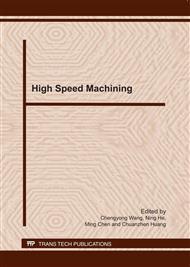p.515
p.523
p.529
p.535
p.542
p.549
p.555
p.561
p.566
The Process Strategies of Mould High-Speed Machining and their Applications in the Environment of PowerMILL
Abstract:
High-speed machining requires the support of high intelligent CAM software as well as customized machining strategies and properly selected machining parameters. Only by combining the two can the advantage of high-speed machining be made full use of. Compared to ordinary NC cutting, high-speed machining has special requirements for process strategies, CAM system and tool path. A complete tool path includes approaching/retracting tool, moving tool and tool path. Based on the above principles, a mould part is successfully processed using the PowerMILL software at the high-speed machining centre of DMG-DMU40T. The maximum hardness of the mould part is HRC50. There’s a 30 degree corner in the cavity with a transition radius of 3mm. The whole process can be divided into three stages: rough, semi-finish and finish machining and each stage involves the selection of tool path, the selection of tool, the selection of cutting parameters (including spindle speed, feed speed and depth of cut), and the application of PowerMILL specific machining methods (such as Race-line machining, rest roughing, automatic trochoidal machining, 3D offset finishing and etc).
Info:
Periodical:
Pages:
542-548
Citation:
Online since:
March 2011
Authors:
Keywords:
Price:
Сopyright:
© 2011 Trans Tech Publications Ltd. All Rights Reserved
Share:
Citation:


